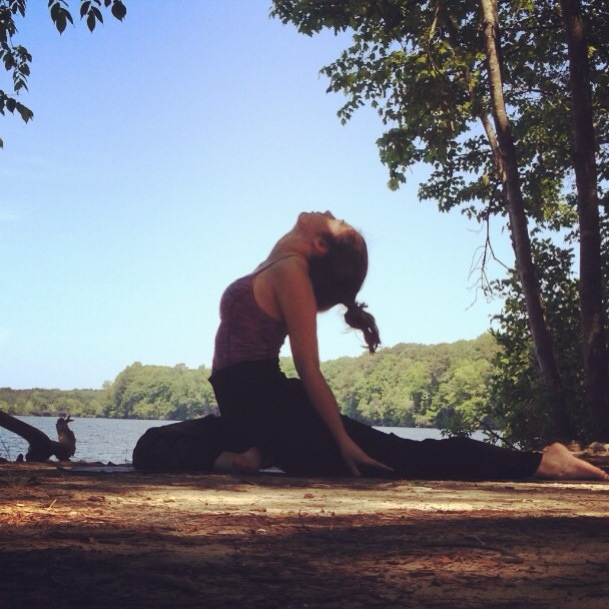
Yoga is a significant part of my life, both in practice and teaching. I am constantly learning. On Tuesday night, my teacher’s words struck a chord with me. She guided the class through a backbend series and described the vulnerability that comes with back bending as an opportunity for growth.
I’m a body type that finds forward bending, easy, comfortable. Back bending, on the other hand, is scary, uncomfortable, destabilizing. Yet, when you nail a solid back bend, it feels so good, you are so open, you feel free.
But why are backbends so scary?
Often, yoga instructors will talk about backbends bringing out strong emotions in practitioners. Whether you are flexible or stiff in your spine, it is the unexpected strength, stamina and flexibility required for most back bending movements that takes us by surprise.
There are two ends of the emotional spectrum for those who begin to incorporate back bending into their practice. One end fears them with both rational and irrational emotions, and therefore avoids going too deep into any backbend. The other (where I often find myself) easily drops into Urdhva Dhanurasana, sometimes hitting our heads. This can create anxiety and fear where there never had to be any. In learning to do a well-supported, sustainable backbend, you will gain a strong understanding of your body and mind.
The assistance of a teacher can be beneficial whether we are afraid of backbends, or do not yet have the strength or flexibility required. In pushing ourselves a little deeper, or backing off to a posture we can sustain, we find a place that our body is electrified. Our nervous system is buzzing, and suddenly a variety of strong emotions ranging from joy, to irritation, to intense sadness comes flooding into this posture. The full engagement required for the posture releases tensions and allows you to breathe through the difficult emotions. This can happen in a beginner or an advanced backbend. When things are difficult, scary and emotional it is hard to remain calm. The guidance of an experienced teacher is crucial to this process. With sound instruction, your body can be guided until you are able to fully sustain that posture on your own.
Asanas (yoga positions) are about a psychological balance. On one hand, you need to push yourself to an area that is unfamiliar and uncomfortable. There is a sweetness to going beyond your comfort zone, in finding a place that you grow. On the other hand, if you push too hard, you put yourself in a place of pain and risk injury. This pulls you back into your comfort zone; the wall is much higher to climb the next time you try to go beyond your boundaries. In this way, pushing too hard limits our growth.
Life choices are much the same. We often find ourselves in comfortable rhythms; patterns of interactions with places and people we identify with or provide us with comfort. This can be fulfilling, but we find ourselves looking over the fence, wondering what it might be like over there. At the same time, we fear traversing that ground because it would mean letting go of our familiar patterns, the patterns by which we define ourselves.
I found myself in this position in October of last year. I had a loving community, a committed partner, job opportunities—everything was there. However, there was an itch. It started subtly, where it could be ignored. But day by day the itch grew until it was alive, clawing at me from the inside. I couldn’t ignore it. This itch wanted me to go anywhere but where I was. I was conflicted, I was afraid.
I let that fear push me. I chose to leave—my friends, partner, and community—and take up an internship overseas. I took no guidance from those around me, those who were more experienced. It was like collapsing onto my hands in a backbend without warming up, or ever even learning how to do a backbend. I just believed I could do it without putting in the hard work to prepare myself. I hit the ground head first, falling, and injuring myself. I was hurt and was not in a place of comfortable growth. Those around me could only watch, as I insisted on doing it.
I resented the place I had come to, I longed for the comfortable spaces I had left behind.
Despite this initial shock, it brought me to a place where growth could happen. From lying with my back flat on the floor, I built strength and stamina. I learned how to support myself; I learned how to push a little each day. Preparing myself, understanding the vulnerability I was experiencing, and learning how to accept that feeling. I didn’t know what it meant to leave, or what it would feel like to be in that position.
We need to learn where we are on the back bending spectrum. We need to get in touch with our default behaviours, and how we approach situations. Do we often push guidance away? Are we going beyond our comfort zones? Are we pushing ourselves to a place of injury and harm? It is essential to understand your boundaries, paying close attention to the places where there is room to grow as well as the boundaries you need to respect.
If you hit your head, the most important thing is to reassess and try again, right away. Ideally, you can seek the help of a teacher. This is to avoid building aversion to the movement. Whether you feel you are hesitating to do backbends, or overly eager to launch yourself into the posture, it is important to work from a safe place. Be open to the guidance of an experienced teacher to help you gain perspective on your practice, be honest and respectful of where you are in your practice, and in your life. In challenging places in our lives, we have our friends, teachers, mentors, and family who can offer perspective. Foremost, trust yourself, but do not fear being open to the support of those who love and care about you.
Only now can I tell you, being here in the fully supported version of this posture, that this version of myself is the most liberating experience. It informs my other experiences, as I have built strength and awareness through pushing myself and respecting my boundaries. I have a vantage point on my previous self that I could never have had, if I’d continued my regular patterns.
From here, I am able to make decisions with more clarity. I still have a lot to learn, and there are endless postures to master. I wish I could have gained this perspective without having to fall on my head, but I am one of those unfortunate souls who learns from doing it themselves, no matter what wisdom others have to offer. But now, I have a broader picture of myself.
It is about being able to experience fear and deal with it in a way that is productive. Fear does not hinder me, neither does it make me rash and ignorant, causing me to deal with it in a way that harms both myself and those around me. Fear can rule us by trapping us, or by sending us on a mad rampage over a cliff. We must work day by day to challenge fear, to work with fear, and accept fear.
In learning to do backbends, we choose how to live our lives.
Author: Leah Elizabeth Morris
Image: Flickr
Editor: Emily Bartran






Read 0 comments and reply